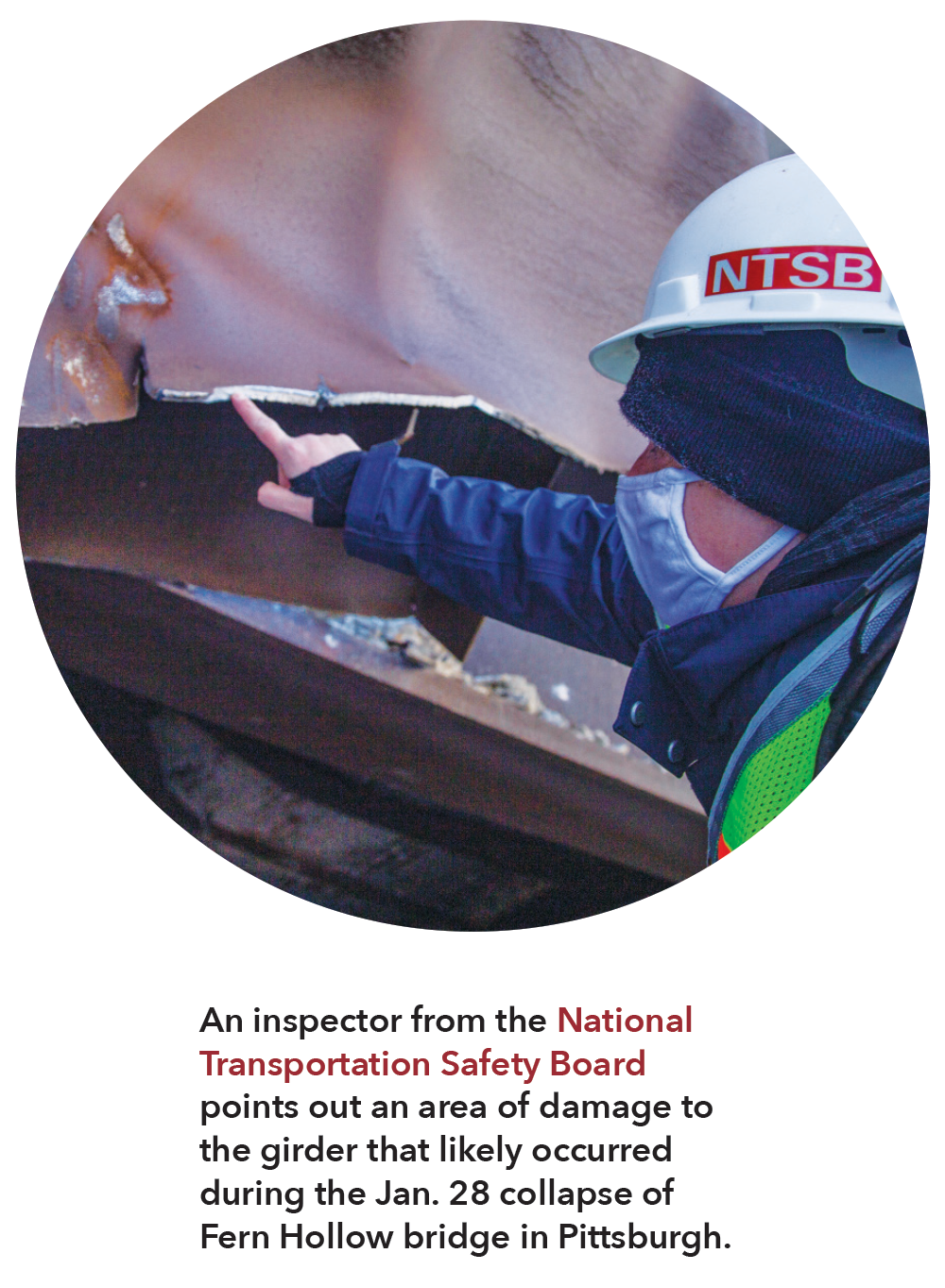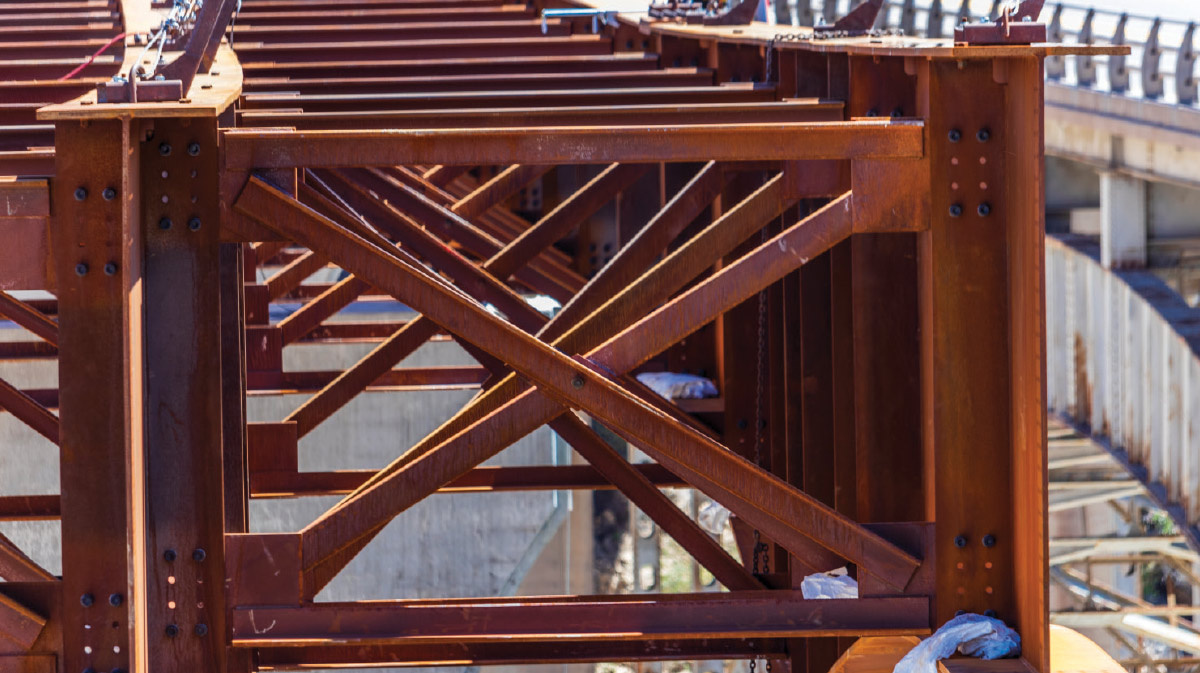
ittsburgh-area residents learned about the structural deficiency of Fern Hollow bridge when it collapsed Jan. 28. Ten people were injured. In a preliminary report issued Feb. 7, the National Transportation Safety Board said the 447-foot-long bridge experienced a structural failure and fell about 100 feet into the park below.
Built in 1973 from uncoated weathering steel, the bridge consisted of a three-span, continuous rigid K-frame structure with two welded steel girders, welded steel floor beams, and rolled steel stringers. Each girder was supported by two welded steel frame legs, also made of uncoated weathering steel. Although certain areas of the welded steel girders were identified as being fracture critical, no primary fractures were found in these areas, NTSB states.
 the demand [for steel] will be sustained over time.
the demand [for steel] will be sustained over time. 
On Jan. 14, the U.S. Department of Transportation (DOT) launched the historic Bridge Replacement, Rehabilitation, Preservation, Protection, and Construction Program (Bridge Formula Program), made possible by the Bipartisan Infrastructure Law. The program, to be administered by the Federal Highway Administration (FHWA), provides $26.5 billion to states, the District of Columbia and Puerto Rico over five years and $825 million for tribal transportation facilities.
Based on average repair and replacement cost data published by the FHWA and submitted by state transportation authorities, ARTBA estimates the cost of identified repairs for all 224,000 bridges—including the 43,578 that are deemed structurally deficient—is $260 billion.
Gov. Gavin Newsom said California will receive nearly $850 million in initial funding in year one of a five-year bridge repair program. “With more than 26,000 bridges in California—including some of the busiest and most iconic in the nation—we thank the administration for this historic investment to make our bridges more resilient.”
California will receive roughly $4.2 billion over five years to address highway bridge needs. Caltrans and local transportation agencies will target the funds to improve the nearly 1,500 bridges rated in “poor” condition in the state. California’s 2022-23 budget proposes a nearly $15 billion investment in transportation and infrastructure overall.
Massachusetts plans to replace the Rourke Bridge in Lowell, using funds from the federal government as well as state funds. The cost is estimated at $170 million. The state expects to receive $9.5 billion over five years under the Bridge Formula Program. The governor listed 181 bridges that will be funded for repair or replacement through 2027. The state expects to address more than one-third of its structurally deficient bridge backlog.
 [This] is the largest ever investment for bridges specifically.
[This] is the largest ever investment for bridges specifically. 
Kentucky Gov. Andy Beshear unveiled a new infrastructure plan that includes projects using up to $6.2 billion in federal funds through 2028. Proposed projects include the Brent Spence Bridge Corridor project in Northern Kentucky, including construction of a companion bridge to share the volume of traffic on Interstates 71 and 75 between Covington and Cincinnati; and continued development of the I-69 Ohio River crossing at Henderson. “Kentucky owns and maintains over 9,000 bridges,” notes Kentucky Transportation Cabinet Secretary Jim Gray.
Millions of dollars
New Jersey awarded a $1.56 billion contract to Sweden’s Skanska to build the 2.5-mile-long Portal North Bridge replacement in Hudson County, New Jersey. The contract includes the replacement of the existing bridge with a new two-track fixed structure crossing over the Hackensack River. Construction will begin in the second quarter of 2022 and is scheduled for completion in 2027. Skanska earlier won a $161 million state contract to rehabilitate sections of the Pulaski Skyway in Jersey City, New Jersey. The contract includes rehabilitating the structural steel truss and spans. Completion of that project is scheduled for 2026.
Florida expects to start work this quarter to replace the SR A1A North Causeway over the Intracoastal Waterway. Built in 1963, the existing two-lane, 2,100-foot-long bridge, has structural deficiencies. The new bridge will be 4,152 feet long and extend over the waterway, a railroad and a local highway. The state expects to complete the $91 million bridge in 2026.
Back in Pennsylvania, Gov. Tom Wolf recently visited the Route 462 Columbia-Wrightsville Bridge spanning the Susquehanna River. Built in 1930, it is listed on the National Register of Historic Places. The bridge is slated to undergo a major rehabilitation beginning in 2023.
“The passage of the Bipartisan Infrastructure Law is the largest federal infrastructure investment in decades, and the largest ever investment for bridges specifically,” said PennDOT Acting Deputy Secretary Mike Keiser. The new law fosters the largest infrastructure investment since 1993 in the state. “We really hadn’t had any adjustment at the federal level since that time,” he said. Pennsylvania is expected to receive about $4 billion in new federal highway and bridge funding over five years, including $1.6 billion for bridges.
SMA President Philip K. Bell says that although infrastructure investment is “incremental in nature, the demand will be sustained over time. Our members have invested in additional capacity” because much of this U.S. infrastructure will be built using domestic materials and labor. Every $100 billion of investment can incrementally increase steel demand by 4 million to 6 million tons, Bell says. “We are excited and looking forward to this.”

“The new bridge funding is vital to our industry, [which has] developed alloys that allow for reduced maintenance and a greater service lifespan at a cheaper cost over the entire life cycle of a bridge,” according to Aluminum Association President and CEO Tom Dobbins.